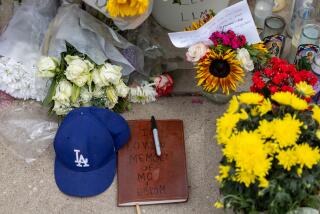Change Slow, Uncertain for D.C. Police
When this city’s police detectives linked up by telephone with investigators from Modesto earlier this week to sort out their roles in probing the disappearance of Chandra Ann Levy, the two sides had come a long way from their first discordant contacts.
Just a week earlier, the D.C. Metropolitan Police detective leading the Washington end of the investigation spurned aid from a Stanislaus County officer who had flown east to join the effort to find the missing woman. Modesto authorities were left baffled and Levy’s parents were openly angry.
Levy, 24, was last seen April 30. After an internship at the federal Bureau of Prisons in Washington, D.C., she had been preparing to return home to Modesto and then to her graduate school commencement at USC.
D.C. Police Chief Charles H. Ramsey moved quickly to defuse the situation, soothing the Levys, staying in close contact with Stanislaus County Sheriff Les Weidman and ordering his investigators to work with their California counterparts.
“It was absolutely critical that we collaborated because of the potential of spinning off into two separate investigations,” said Stanislaus sheriff’s spokesman Kelly Huston. “Chief Ramsey took an active role and it clearly helped.”
Ramsey’s swift reaction was revealing. It showed how much the culture of Washington’s long-beleaguered police department has changed in the last few years--and how far it still has to go.
Overwhelmed for years by every conceivable police malaise, from shootings of suspects to budget woes so pervasive that officers had to pay for gasoline for their patrol cars, “D.C. Metro” is still reeling in the third year of Ramsey’s tenure as chief.
Even as Ramsey has won high marks for extending community policing into poor neighborhoods and reducing the city’s once-soaring violent crime rate, he has had to grapple recently with questions about the competence of his investigative units.
The department was sued just two weeks ago for $2 million by a New Hampshire deaf student mistakenly targeted as a suspect in the slaying last year of a Gallaudet University student. While Thomas Minch was being investigated by a grand jury, detectives failed to notice that the victim’s wallet had been stolen--a fact that became glaringly apparent when the thief was arrested in a second Gallaudet slaying and charged in both cases in February.
“It was a botched investigation, completely inadequate. It makes you wonder about the basic abilities of some of these people,” said Joel M. Finkelstein, a lawyer and former D.C. prosecutor who filed Minch’s lawsuit.
Top D.C. Metro officials have been open about lapses in investigative techniques and long-standing difficulties in solving and clearing murder cases. Ramsey and his top aides are moving to toughen standards, increase training and centralize the command of their 380 detectives. And they are looking into how the department’s initial investigation of the Gallaudet case in October went wrong.
“We are going in and analyzing strengths and weaknesses,” said Executive Assistant Police Chief Terrance W. Gainer, Ramsey’s second in command. “There’s a lot we still have to do.”
Gainer and Ramsey, formerly top officials in the Chicago Police Department and Illinois State Police, were brought in by D.C. leaders three years ago to right a department staggered by years of chaos and corruption.
Ramsey ordered a major decentralization of investigators, shuffling detectives out of the department’s downtown headquarters and into neighborhood station houses. Even after he modified the campaign, reestablishing a central detective command, Ramsey’s move sparked grumbling among veterans.
Morale is down, said Sgt. Gerald “GG” Neill Jr., who heads the local police union and was a homicide detective in the mid-1990s. Neill worries that the new system is also making it more difficult for officers to solve crimes.
“It’s not working the way Ramsey wants it to,” Neill said. In many cases, he said, detectives no longer have stable partners they can count on to provide continuity in unsolved cases.
“They’re losing the daily contact they need,” Neill said. “It’s harder to find a partner you can sit down with to figure things out.”
D.C. Metro officials are also grappling with the fallout from several episodes that indicate shortcomings and poor training among detectives. Already trying to raise a notoriously low homicide case clearance rate that hovers in the 50% range, police officials now are sorting through the aftershocks of costly investigative mistakes.
Three separate lawsuits have been filed against the city in recent months. Each alleges that detectives’ errors led to the arrests of innocent men in murder cases.
The department is probing its handling of the Gallaudet slayings--”less for finding fault than for learning how we should have handled it,” Gainer said. He admitted, though, that disciplinary action could result.
Detectives zeroed in on the wrong suspect for nearly five months in the Gallaudet case. Investigators arrested Minch in the death of freshman Eric Plunkett, then dropped the charge. But they continued to gather evidence against Minch, Finkelstein said.
“Tommy was under suspicion all that time; he lost a year of school, and all for nothing,” Finkelstein said.
Plunkett’s debit card was used by Joseph Mesa Jr., another student down the hall. Mesa was later charged in Plunkett’s murder and the slaying of student Benjamin Varner.
In a similar snafu, police were sued for $60 million last September by a man once arrested for the murder of a hotel waitress. Detectives contended the suspect had used the dead woman’s ATM card. They later acknowledged the card belonged to the man’s girlfriend. And a third $10-million lawsuit alleges that a man spent 13 months in jail on murder charges because detectives lied to him about evidence linking him to the crime.
Gainer said that the department is toughening standards for detective applicants and requiring more training for investigators. At least two dozen detectives are on probation and undergoing intensified training, he said.
In Modesto, sheriff’s officials said they had no concerns about D.C. Metro’s past when they asked two weeks ago to join in the East Coast department’s probe of Levy’s disappearance.
But when Mario Cisneros, a Stanislaus sheriff’s detective, flew to Washington on May 12 to offer his services, he was rebuffed by Ralph Durant, the D.C. detective heading the probe.
“It was a miscommunication,” Huston said.
Officials from both departments say they have since spent repeated phone calls sorting out the details of how each police agency will work its part of the probe. Stanislaus County is concentrating on leads on the West Coast, while D.C. Metro detectives continue in their lead role.
“We think we’ve got pretty good rapport now,” Huston said.
The Levys, too, seem more at ease, said Shelley Streeter, a volunteer at the Carole Sund-Carrington Memorial Reward Foundation, a Modesto group aiding the parents.
“Now they feel very much in the loop,” Streeter said.
While Modesto detectives last week checked out apparently unfounded sightings of Levy in Reno, Nev., D.C. police searched along a jogging path and combed for evidence outside Levy’s apartment. Both agencies have stayed in close touch.
“There’s always a getting-to-know-you phase when you’ve got several agencies involved,” said Gainer. “We’re not clearing things with each other. But we are keeping each other up to date.”
More to Read
Start your day right
Sign up for Essential California for news, features and recommendations from the L.A. Times and beyond in your inbox six days a week.
You may occasionally receive promotional content from the Los Angeles Times.






